May 26, 2018
Visit to Cambridge University’s Mullard Radio Astronomy Observatory – 12th May 2018
Report by: Christina Chester
On Saturday 12th May, a group of 20 Flamsteed members ventured out to the University of Cambridge’s Mullard Radio Astronomy Observatory. Located at Lord’s Bridge near the small village of Barton in Cambridgeshire, the site was once a railway station on the Varsity Line that ran between Oxford and Cambridge. That, in fact, is where our tour began. Stood on what was once the eastbound platform, our guide for the visit, Peter Doherty, explained that the disused long and level stretch of line provided a handy track for The Ryle Telescope (formerly known as the 5-km Telescope).
After a brief introduction, we moved indoors to the lecture room located in what once was the station house of Lord’s Bridge railway station, where we heard about the darker history of the site. In 1939, prior to the site being sold to Cambridge University where the Cavendish Laboratory established the Mullard Radio Astronomy Observatory, it was used by the RAF as a forward storage facility for between 750 – 1250 tons of high explosive and incendiary bombs. Known then as Lord’s Bridge Air Ammunition Park (RAF Ammunition Depot), the southeast corner contained the Lord’s Bridge Forward Filling Depot for filling mustard gas shells. We learnt of an explosion that had taken place that very nearly could have spelt a major disaster from the spread of toxic vapour over a wide area.
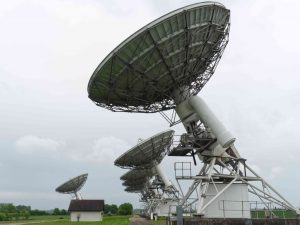 Armed with some historical background about what otherwise appears to be an ordinary place, we divided ourselves into several cars and drove to the first point of interest on the tour – the Arcminute Microkelvin Imager Large Array. Large, it certainly is! This impressive array consists of eight 12.8m equatorially mounted parabolic antennas, clustered together to carry out observations of galaxy clusters by looking at the Cosmic Microwave Background (CMB). Originally, these imposing antennas formed The Ryle Telescope, forming an eight-element interferometer but now, they are used together with the Arcminute Microkelvin Imager Small Array, which we were to be introduced to later on our visit. The Large Array is used to image the radio sources that contaminate the Small Array observations of the CMB.
Armed with some historical background about what otherwise appears to be an ordinary place, we divided ourselves into several cars and drove to the first point of interest on the tour – the Arcminute Microkelvin Imager Large Array. Large, it certainly is! This impressive array consists of eight 12.8m equatorially mounted parabolic antennas, clustered together to carry out observations of galaxy clusters by looking at the Cosmic Microwave Background (CMB). Originally, these imposing antennas formed The Ryle Telescope, forming an eight-element interferometer but now, they are used together with the Arcminute Microkelvin Imager Small Array, which we were to be introduced to later on our visit. The Large Array is used to image the radio sources that contaminate the Small Array observations of the CMB.
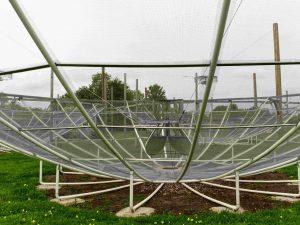 Back in the cars and on route to the next point of interest, came across a series of mysterious-looking structures constructed with chicken wire and plastic drainage pipes. We stopped briefly and learnt that these are in fact prototypes of the Hydrogen Epoch of Reionization Array (HERA), a collaborative project to construct a new array in South Africa.
Back in the cars and on route to the next point of interest, came across a series of mysterious-looking structures constructed with chicken wire and plastic drainage pipes. We stopped briefly and learnt that these are in fact prototypes of the Hydrogen Epoch of Reionization Array (HERA), a collaborative project to construct a new array in South Africa.
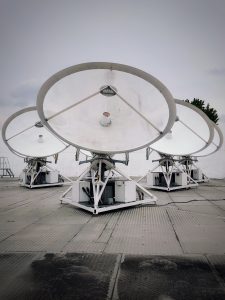 At our next stop, we had arrived at an outbuilding entrance. Peter led us through an inconspicuous door and what appeared on the other side was quite spectacular! The Arcminute Microkelvin Imager Small Array consists of ten 3.7-m dishes, similar in design to those of the Large Array. To our delight, the ten dishes suddenly began slewing. Their movement appeared so graceful – a marvel of engineering art!
At our next stop, we had arrived at an outbuilding entrance. Peter led us through an inconspicuous door and what appeared on the other side was quite spectacular! The Arcminute Microkelvin Imager Small Array consists of ten 3.7-m dishes, similar in design to those of the Large Array. To our delight, the ten dishes suddenly began slewing. Their movement appeared so graceful – a marvel of engineering art!
Located close by is the Cambridge Optical Aperture Synthesis Telescope (COAST), which is a synthesis of five optical telescopes that had mainly been used as a test-bed for subsystems and components intended for future optical interferometer arrays. One of the unit telescope protective covers was pulled ajar for us to get a glimpse of the mirrors. While in this area, our attention was drawn to another prototype, this time, a low-frequency antenna designed for the Low-Frequency Aperture Array for the Aperture Array telescope of the Square Kilometre Array (SKA). These antennas will be used to measure very faint signals, exploring the edge of the universe where the matter that everything is made of emerged out of the plasma of the Big Bang.
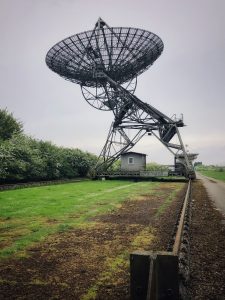 Thrilled that we had got to witness the makings of this ambitious project, we jumped back into the cars and drove to our next port of call. As we turned a corner, the large, intricate frameworks of the One-Mile Telescope antennas came into view. Their commanding presence adorns the Observatory grounds and they themselves are a thing of sculptural beauty. Constructed in 1964, the three 18-m antennas once formed a radio interferometer with a baseline of around a mile where two were kept stationary and the third antenna could be moved along a half-mile track; a track that had also been used by the Half-Mile Telescope.
Thrilled that we had got to witness the makings of this ambitious project, we jumped back into the cars and drove to our next port of call. As we turned a corner, the large, intricate frameworks of the One-Mile Telescope antennas came into view. Their commanding presence adorns the Observatory grounds and they themselves are a thing of sculptural beauty. Constructed in 1964, the three 18-m antennas once formed a radio interferometer with a baseline of around a mile where two were kept stationary and the third antenna could be moved along a half-mile track; a track that had also been used by the Half-Mile Telescope.
Peter guided us towards a small building where we stepped into a scene frozen in time. The building houses the control room for the One-Mile and Half-Mile telescopes with controls and signal recording equipment that had been used to produce the 5C catalogue of radio sources seemingly left abandoned. Like a tiny, interactive museum, a reel-to-reel paper tape reader, complete with its punched tape sits within one of the vertically mounted racks. On a desk beside the window, an oscilloscope lies with a cable plugged into the input, as though waiting to analyse waveforms. Printed charts and paperwork, including the Copilot’s Guide to the One-Mile Telescope, can be found about the room and the control panel itself is a myriad of buttons and knobs, each itching to be pressed.
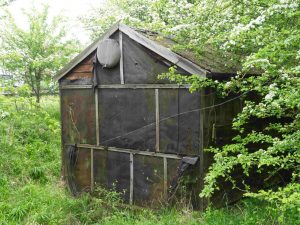 Back to the reality of present time, we left the control room and headed along the track way for a while, deeper into this wonderland of historical significance. We soon turned off and followed Peter down a small ditch and through some bushes, growing curiouser and curiouser about what we might find next. To our astonishment, it was the location that Jocelyn Bell Burnell made the first detection of a pulsar in 1967. Disappearing into the undergrowth are the remains of the Interplanetary Scintillation Array. Not much remains to be seen of what was once a 4-acre array as the land has since been repurposed. Carefully nested in amongst the trees and bushes is a small, weathered wooden shed that we learnt housed the receiving and recording equipment used by Jocelyn.
Back to the reality of present time, we left the control room and headed along the track way for a while, deeper into this wonderland of historical significance. We soon turned off and followed Peter down a small ditch and through some bushes, growing curiouser and curiouser about what we might find next. To our astonishment, it was the location that Jocelyn Bell Burnell made the first detection of a pulsar in 1967. Disappearing into the undergrowth are the remains of the Interplanetary Scintillation Array. Not much remains to be seen of what was once a 4-acre array as the land has since been repurposed. Carefully nested in amongst the trees and bushes is a small, weathered wooden shed that we learnt housed the receiving and recording equipment used by Jocelyn.
By this point, the rain had set in hard so we dashed indoors into the shelter of the control building for the Ryle Telescope where we stepped back in time once again. Equipment racks and the control panel (complete with a klaxon button) can be seen as they were left in the 1970s, as though everyone working there had walked away and locked the door behind them.
Three hours into the tour, it was time for us to walk away too. We left the Mullard Radio Astronomy Observatory indebted to Peter Doherty who had volunteered his free time to provide Flamsteed members with an informative and entertaining afternoon.
Report by Christina Chester
Photos by Robin Bullen and Christina Chester
Posted under: Flamsteed, Meeting Report, Radio Astronomy, Society Trip


















You must be logged in to post a comment.